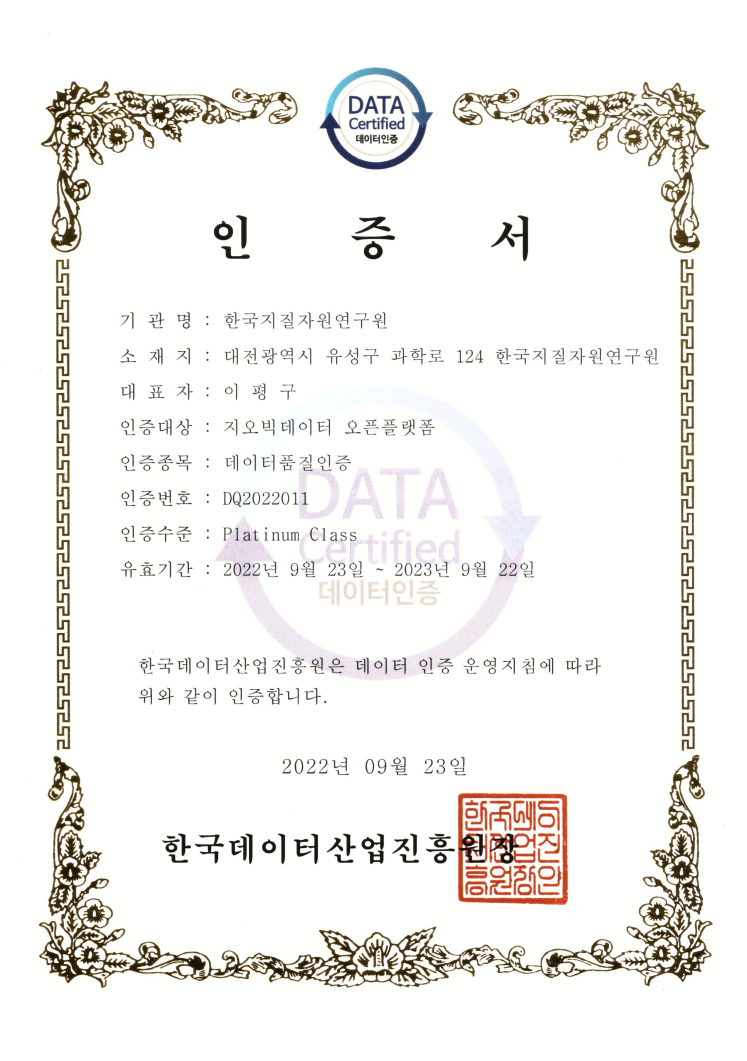데이터 품질 인증서

| 자료유형 | KIGAM 보고서 |
|---|---|
| 제목 | 골재자원부존조사 : 경기도 남부 육상, 산림골재 및 용유도해역 바다골재. 제I권 |
| 저자 | 김주용 |
| 언어 | KOR |
| 청구기호 | KR-98-C-21.1-1998-R |
| 발행사항 | 韓國資源硏究所, 1998 |
| 초록 | 1980년대말에서 1900년대 초에 전국 골재수요가 급증하여 골재 공급부족에 따른 사회적 물의를 경험하였던 정부는 1992년부터 새로이 골재채취법을 제정하여 골재수요의 안정적 공급을 확보하기 위한 합리적 방안을 모색하기 시작하였다. 그 일환으로 통상산업부에서는 국내 골재산업육성을 위하여 전국적으로 골재자원기초조사를 위한 제1차 5개년 계획을 수립하였으며 1997년도까지 조사를 완료하였다. 지난 제1차 5개년간 골재부존조사 연구사업은 하천, 바다, 산림골재로 구분되어 수행되었고, 하천골재는 현재 하상을 중심으로, 산림골재는 개발지역과 주변 추천지역을 중심으로, 그리고 바다골재는 경기만과 서남해 연안해역에 대하여 부존조사를 실시하였다. 제1차 5개년 골재 기초조사 결과, 현 하상에 대한 하천골재조사는 대체로 완료되었다. 향후에는 하천 주변의 구하상, 즉 육상골재를 대상으로 연차적으로 정밀조사를 수행할 계획이다. 육상골재자원부존의 개략조사를 위하여 한국자원연구소에서는 항공사진과 인공위성 영상사진들을 통하여 골재자원의 개략적 분포에 대한 확인과정을 거친 후, 현장확인을 위한 야외지질 분포조사, 시추조사, 물리탐사, 측량 등을 실시하여 골재자원의 종류별 부존범위 및 발달심도를 파악할 예정이다. 육상골재 시추조사로부터 획득한 골재시료로부터 물성특성을 측정하여 육상골재로서의 이용가능성과 품질 특성을 진단하려고 한다. 산림골재에 대한 지난 5개년 동안의 부존조사는 전국에 분포되어 있는 산림골재부존지역에 대한 개략조사이며, 조사연구 결과 산림골재의 전국적인 개발실태가 파악되고, 광역적인 지질도 (1/25,000 축척)가 작성되어 개략적인 부존량과 개발가능한 추정(예상) 매장량을 파악하였다. 1997년도 까지의 산림골재 부존조사는 전국적으로 개발되던 골재석산과 그 주변부에 대하여 개략적인 지질조사와 물성특성 및 골재석산의 개황 등을 조사하였으나, 향후에는 5년간에는 기개발 골재석산중 확장가능지역과 미개발지역에 대한 1:5,000 축적의 지형도를 이용하여 정밀지질조사를 실시할 예정이다. 유망대상지내에서 단위지역을 선정하고 개발 가능성을 추가로 검토하여, 기존 골재업체가 바로 활용할 수 있도록 산업화 단계와 연계된 제반 기초연구를 실시하고자 한다. 또한 골재물성을 위하여 세부적인 물성시험을 실시하여 골재의 품질을 관리하는 기준을 설정코자 한다. 바다골재 부존조사는 지난 5개년간 경기만남부와 북부, 군산해역, 신안남부와 목포해역에 대하여 유망부존지역에 대한 해양지질조사 및 해양물리탐사를 실시하였고 바다 세골재의 물성특성도 규명하였다. 금년부터 5개년간 실시되는 바다골재 부존 조사는 서해의 경기만의 용유도해역, 태안반도와 변산반도 해역, 서남해의 해남과 완도해역에서 정밀조사를 실시할 계획이다. 바다골재 부존조사는 연구소 전용의 탐사선인 137톤급의 탐해호를 이용하여 해저지형과 지층구조 해석을 위한 해저 탄성파탐사를 실시하였고, 표층 및 주상시료를 채취하기 위한 해저 천부지층에 대한 시추조사를 실시한다. 1998년도는 제2차 골재자원부존 정밀지질조사를 실시하는 첫해로서 제2차 골재수급계획 5개년 기간동안 골재물량확보를 위하여 기초조사를 실시하는데 목적이 있다. 금년도의 육상 및 산림골재 조사지역은 수도권(경기남부 및 인천) 일대이며, 바다골재 부존조사 지역은 용유도 해역 일대이다.... Until 1990, there have not yet been any complete geological studies on these constructional materials. From 1993 to 1997, a preliminary research of aggregate resources was carried out in the Korea Institute of Geology, Mining and Materials(KIGAM), not only for assessing a nationwide resource potential of riverine, marine and crushed aggregates, but also analyzing the physical properties of these aggregates. The aggregates were surveyed for the last 5years by Aggregate Research Group of KIGAM(ARGK) for the purpose of providing government planners and decision-makers with basic data related to development plan, usage and quality of them. The necessity of aggregate resources potential in Korea is increasing with a rapid economic growth since 1980s. Construction activities have been increased drastically for last two decades. Such economic activities are much concentrated at big cities in Korea, which have been already overpopulated and recently new neighbouring cities are under construction at the surroundings of the cities. This new urbanization asked for and appropriate supply of raw construction materials such as cement, sands and gravels. Especially in these days sands and gravels along the riverine areas are reached at the limit of supply because gravel pits are rapidly moving farther from the demanding places. The 50% of the total present consumption of these sands and gravels comes from riverine deposits; 30% from marine sands and the other 20% from rock crushes. The riverine deposits, including both sands and gravels of a present river channel and those of the old fluviatile system, are still the main source of aggregate resources. Nowadays the aggregate derived from the present river channel is decreasing, while that of the old fluviatile system are gradulaly increasing for the source of fluviatile aggregate. Although it is increasingly necessary to investigate the marine and crushed aggregate resources potentail in Korea where a current analysis indicate that the supply of riverine aggregates gradually decreases, the riverine aggregates are consumed preferentially because they have better quality for constructional materials than marine or crushed aggregates. For the management of quality of aggregates, sands and gravels, as well as crushed aggregates, are to be analyzed for their mechanical, phyco-chemical and mineralogical properties. For these purpose, it is proposed here that the term, "aggregate" as a collective term, is defined as any natural or semi-artificial rock debris or mineral grains, as well as any raw constructional materials of economic value, specifically of sand and gravel sizes, even made form artificial manufacture. With these definition of aggregates as raw constructional materials the aggregates constitute 70-80% of the volume of concrete, so the type and quality of them are very significant to determine the quality of concrete itself. In this sense the quality of concrete is mostly guaranted by correct and adequate use of aggregates, thus it is very much important that the physical properties of which are throughly analyzed. During the last 5 years period, the Aggregate Research Group of KIGAM(ARGK), especially fluviatile aggregate research team, had investigate nationwide river basins. Many fluviatile gravel pits have been made on local exposures along the main rivers basins such as Bookhan river, Namhan river, Keum river, Youngsan River, Nakdong River and so forth. From 1998, the investigation of riverine aggregate resources potential is mainly concentrated on the sands and gravels derived from old riverbed deposits outside of the embankments of the fluvial drainages distributed in the southern capital city embankments of the fluvial drainages distributed in the southern capital city area.... |
| 페이지 | xv, 703 p. |
| 키워드 | 골재자원, 골재, 경기도, 남부, 육상골재, 산림골재, 용유도, 바다골재, 인천 |
|
보고서 다운로드가 활성화 되지 않는 데이터의 경우,한국지질자원연구원 도서관으로 문의 부탁드립니다. |
|
댓글